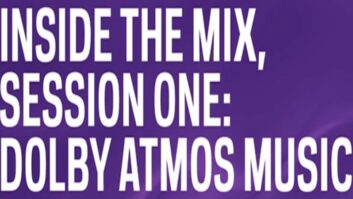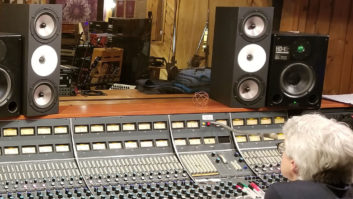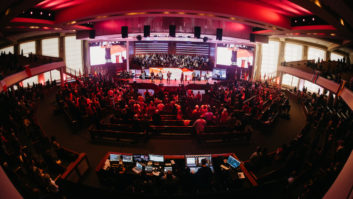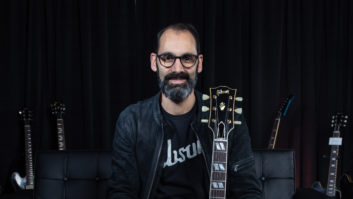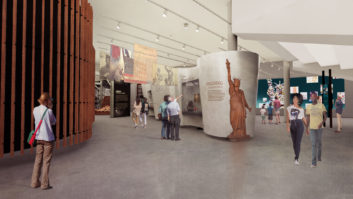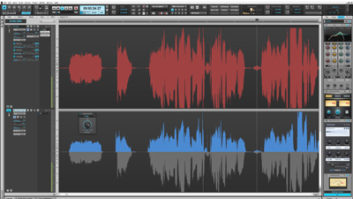Audio hardware and software manufacturers do not exist in a vacuum. They are as much a part of the industry as the talented artists who tweak, abuse, stretch and “play” their offerings, and as such, they respond to myriad influences that permeate the marketplace. Manufacturers inhabit the supply side of the equation, and while they often merely respond to the demands of engineers, producers and artists, other times they react proactively ahead of a demand, coming up with solutions where nobody even knew there was a problem, let alone a new solution. In this sense, pro audio is just like any other industry.
But in many ways, the audio industry is different from others in the tech sector. Where else do the “users” pay a premium for 50-year-old technology while they balk at a $499 price tag for the most sophisticated multi-effects software plug-in? Where else do facility owners lovingly refurbish a single classic console module to feed last month’s newest CPU upgrade? Where else would an artist insist on a 50-year-old mic over the latest re-creation tuned in a brand-new factory?
Yes, our hybrid hardware/software world is relatively unique, and as such, manufacturers face constant challenges in assessing where, when and how to bring a product to market. While boutique hardware manufacturers face vastly different development paths from their software counterparts, they deal with some commonalities determined by the costs of raw materials, wages and other business costs.
The pro audio market in North America can be estimated at approximately $2 billion. With such revenue potential at stake, how does a company secure its fair share of the market? Despite what we might think to the contrary, ours is a highly competitive industry that combines a unique admixture of artistic creativity with Economics 101. And the rules of engagement are dramatically different for dissimilar product offerings. A company focused primarily on software products has a different financial profile than a company that innovates hardware systems. In general, developing software is a front-loaded but continually evolving process, with user feedback and platform enhancements making it imperative that the firm stay ahead of customer demand. Development times can be quick and the costs of production far less than for hardware.
Hardware systems, on the other hand, require a substantial commitment of work hours and investment dollars, usually involving a quantum development toward a brand-new offering — a process that can take years rather than months — and then the implementation of updates to keep it cost-competitive and ahead of the direct competition. Major upgrades need to be planned carefully because, with longer lead times, any prediction about required features, functions and target pricing needs to be as accurate as possible. Software can be revised in just a couple of weeks and shipped/downloaded just as easily.
PRE-PRODUCTION: R&D
With the increasingly rapid pace of technological change, whether in hardware or software, a strong foundation in R&D can spell the difference between surviving as a manufacturer and shutting the doors.
Eventide has evolved from a 35-year-old hardware-only company to one that offers a mixture of dedicated DSP-centric products and TDM plug-ins, which were created to support the company’s users who had migrated to Pro Tools and other DAWs. Currently, R&D accounts for approximately 25 percent of the firm’s gross profit. New hardware can take up to two years to develop from an initial idea; enhancements are innovated more rapidly, but the process needs to be appraised carefully. Eventide continues to manufacture its products in the U.S.
TC Electronic, the U.S. distribution division of the multinational TC Group, defines product features for the North American market. Like Eventide, TC offers both hardware signal processors and plug-ins; by coincidence, this division also enjoyed a 30 percent turnover growth during last year, with close to $90 million per annum from approximately 450 employees. Of critical importance, company sources stress, is the fact that virtually all of the firm’s software and firmware has been written in compiled code to run on Motorola DSP chips and engines. This “Write-Once/Use Many Times” design concept means that once the code has been optimized and de-bugged, it can be transported reasonably easily from one intended platform to another — a major cost-savings in R&D and support staff. (Eventide and other mixed-use manufacturers support a similar strategy; in fact, TDM-format plug-ins use Motorola-complaint DSP instructions to do their magic.)
Turning to the heavy-industry sector — the console manufacturers — there is little doubt that DAW-based offerings are signaling the demise of medium- and large-format mixers, though analog systems continue to offer sonic benefits that might prolong their appeal to a well-heeled client base. Today, it’s all about control. Both Euphonix and Solid State Logic are reaching deeper into the workstation arena, the former with a protocol that allows System 5 control surfaces to communicate with Steinberg’s Nuendo, Merging Technologies’ Pyramix and comparable high-end DAWs. SSL now offers AWS 900 controllers for not only Digidesign under HUI emulation, but also for other DAWs that support the Mackie/Logic protocol.
As part of its migration strategy into the project studio market with AWS 900, XLogic rack units and Waves plug-ins, SSL leveraged its platinum heritage and looked for ways to improve workflow by combining analog processing, monitoring, foldback, talkback, setup recall and DAW control. More than 150 AWS 900s have now been sold, and the company concedes that R&D investment is significant and growing, as witnessed by several product introductions during the past year, with more to come. The company’s new owners are said to be focused currently on remaining entrepreneurial; it is estimated that as much as 20 percent of SSL’s yearly profits — worldwide sales are expected to hit $20 million this year — is allocated to R&D.
Euphonix embraced a long-term strategy in engineering its EuCon protocol for console/workstation bidirectional control. DSP Cores of large-format digital consoles comprise embedded high-speed EQ, dynamics and mixing algorithms, plus I/O functionality — not too dissimilar from a DAW’s topology. So why not use a DAW as the back end for an existent console surface?
Developing the EuCon control protocol swallowed a significant amount of Euphonix’s R&D budget. However, once innovated, EuCon’s major strength is that with accelerating support from software vendors, it brings a growing number of products together into the audio workflow — DAWs, for example, in addition to controlling remote mic preamps. The firm also spends substantial amounts of its revenue — estimated at close to $30 million per annum — on engineering development, including large-format network servers and SAN interconnectivity as part of its vertical product line. Networked systems enable its products to connect a user’s choice of platform, workstation, I/O and software in a configuration that suits the user’s needs.
THE HYBRID MANUFACTURER
Many of the more traditional hardware companies were quick to plunge into the software market. Nowhere is this approach more noticeable than in the flood of recent products from industry heavyweight Digidesign.
Despite appearances to the contrary, Digidesign is a hardware-driven company; stand-alone Pro Tools software accounts for less than 10 percent of the division’s annual take. Even in its early days, close to two decades ago, Digidesign developed hardware that could optimize performance of its core audio editing technologies and connect to the outside world. In fact, until April of last year, with the launch of LE and M-Powered systems, customers could not purchase Pro Tools by itself. In addition to dedicated DSP cards, converters and I/O units, through the range of Control/Command interfaces, the firm now offers ICON and VENUE turnkey production systems with integral mixing and recording. The numbers are impressive; the company estimates that more than 100,000 Pro Tools — powered DAWs have been sold worldwide, with more than 1,000 ICON systems sold in two short years.
“System” is an important word at Digidesign, and one that has been a major factor in product planning in reaction to continually changing market demands. ICON, prior to its launch in April 2004, was in development for close to 30 months; maintaining focus on where the market would be two and a half years into the future, what features it would require and what would be an acceptable price/performance ratio with the result being just what the market wanted.
VENUE was designed as a highly application-specific version of the Digidesign DSP for live performance; reliability and minimal latency were considered critical features. Even the core mixing engine needed to be revisited to ensure that signal processing reacted instantly to front panel adjustments without muting and other funnies.
Digidesign also supports the efforts of third-party plug-in developers, which bring valuable expertise to the innovation program and underscore the product’s integrated, system-level concept. A team of four full-time engineers supports external developers; such an investment of close to $500,000 per year obviously has proven worthwhile, even though it might be difficult to quantify a tangible return on the investment.
While plug-in software from Eventide is based on the firm’s hardware and can be purchased for a fraction of the cost, inherent problems of PC reliability and latency — particularly for live performance and on-air broadcasting — help ensure a viable market for its family of Harmonizer-brand effects. Hardware boxes pack such a wealth of effects that in the case of the H8000FW, the cost per effect is less than $4. Eventide expects to grow its TDM business by executing a simple strategy: to continuously develop and add new plug-ins to its Anthology bundle while keeping the bundle’s cost constant.
TC Group, meanwhile, offers Power Core PCI-compatible cards and FireWire-attached add-ons to enhance the performance of its TC6000-derived plug-ins, which are also available in TDM versions for Pro Tools. Power Core provides a VST/Audio Units environment with powerful copy protection and supports a variety of host applications, including Steinberg Cubase, Apple Logic Pro and MOTU Digital Performer.
SOFTWARE ASCENDANT
Founded in 1994, BIAS is an example of a company that kept faithful to its original vision for sample-editing software. This company, which enjoys annual sales of some $10 million and employs 20 people, remains committed to the Apple platform. Although in the past three years the company has released eight plug-ins that run on both Windows XP and Mac OS X, its flagship product, Peak Pro, continues to operate solely on Mac systems. (Peak was one of the first audio programs to run under OS X, and it will soon be shipping as a Universal Binary application for new Dual Core Macs.)
In terms of growth potential, BIAS cites two avenues of advancement. Protecting software can be problematic, but so far, hardware keys have prevented unauthorized piracy of its pro products. OEM offerings with video NLEs such as Canopus Edius offer one value-added opportunity. Bundling has also secured added sales revenue; the Peak Pro XT package sells for $1,199, and includes applications that would cost $2,000 if they were purchased individually.
Another software-only developer, Cakewalk brings in between $10 and $20 million a year — reportedly comparable to German-based Steinberg. The firm’s SONAR brand has been a market leader for half a decade and was the first DAW to run native 64-bit on PC platforms. While management has looked at hybrid software solutions using dedicated DSP cards or external engines, there is a continuing belief that a software application running under an appropriate operating system — 64-bit Windows and/or Dual Core Macs — can match or exceed other options. And piracy will always be a potential problem; the firm spends development dollars on copy protection and secure online delivery.
Like Cakewalk, Sony Media Software offers a range of applications, from professional-level tools for video, audio and DVD production to products for home studios. The company’s origins are in Sony Pictures Digital Networks, which, back in mid-2003, acquired Sonic Foundry’s desktop software assets division for $19 million. (The original digital streaming and live-event aspects remain under Sonic Foundry’s control.) At that time, Sony lacked a significant presence in the pro audio and prosumer software market — aside from Oxford plug-ins — so the arrangement worked out well. SMS’ estimated yearly sales are now around $30 million, breaking down to an annual growth of about 30 percent in a crowded market. That type of growth can be attributed to three complementary elements: strong leveraging of the Sony brand, a continuing commitment to marketing to ensure high visibility and regular enhancements to the Vegas, Sound Forge and ACID applications, as well as its line of loops, samples and other libraries of digital content. The company’s strategy involves repurposing the higher-end, more expensive programs for the prosumer and MI markets, where cost can be kept necessarily lower because of proven, scalable technology and successful R&D.
DON’T FORGET HARDWARE!
Let’s face it — our industry loves knobs and meters. One company that has focused exclusively on hardware is Manley Laboratories, which currently employs more than 50 people and spends six to eight percent of its revenue on R&D. Innovate, to this analog-centric firm, means developing new concepts for mixing, microphone and signal-processing products; it means leading more often than following. Its key design mantra is “Be First, or Be the Best.” Put simply, it has a cost formula for setting retail prices of a new product, which will result in a wholesale price that makes it profitable; the higher the quantity sold, the faster it recoups a return on R&D investment. (After all, upper management reasons, it is unafraid to market expensive devices if high costs are required to cover build costs.)
In terms of new improvements to older products, the company might re-lay a PCB to make it easier and cleaner to fabricate, engineer an improvement or add user features. To retain customer loyalty, Manley rarely increases retail prices and some products have been available for 10 years or more. The company’s management endeavors to extract higher efficiency out of its workforce rather than hire more people or outsource manufacturing.
Another important issue concerns the way manufacturers can get product lines to their customers; factory-direct is appropriate for high-end products, but low- to medium-cost components — elements that might be ordered via a credit card, for example — are more likely to be purchased through Internet portals or local brick-and-mortar stores. For lower-cost DAW software and plug-ins, online purchases enable instant access; within minutes, an entire studio can be downloaded and fully operational. A recent phenomenon is a growth in distribution partners that are providing value-added services and products. Both Euphonix and SSL are now using GC Pro, the systems integration division of Guitar Center, to carry their lower-end DAW controllers.
“Where’s the money?” reflects David Angress, Guitar Center’s executive VP. “Much of it is driving away on a big brown truck! Far too much money leaks from our industry into the coffers of transportation companies and evaporates as interest paid to banks. In an effort to build a better supply chain, for the past five years, GC has been actively working with vendor partners and shipping companies to move goods faster and more directly, thereby lowering costs of freight and the interest costs associated with holding inventory. Their portion of the resulting profits can be reinvested by manufacturers in additional R&D that takes the state of the art forward at a faster pace; ultimately, better products get to the customer faster at a lower price.”
Mel Lambert, heads up Media&Marketing, a full-service consulting service for pro audio firms and facilities.
